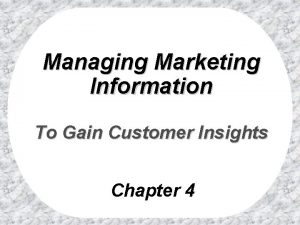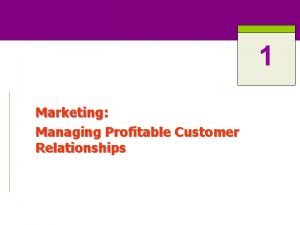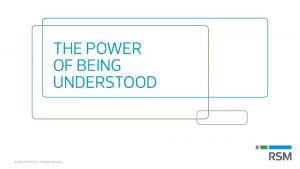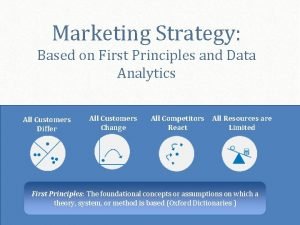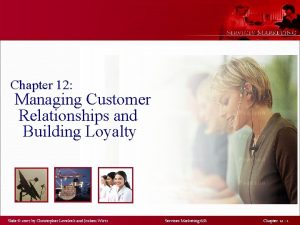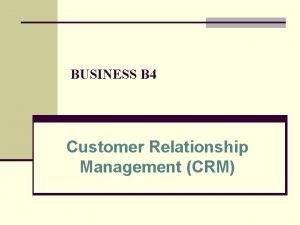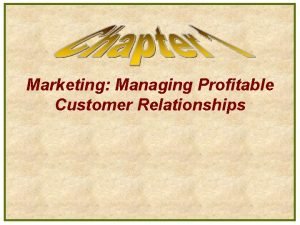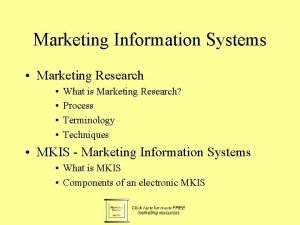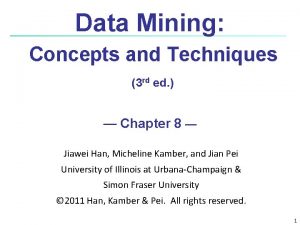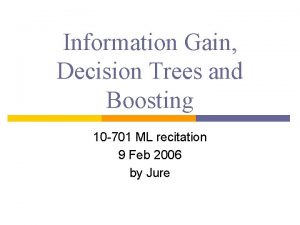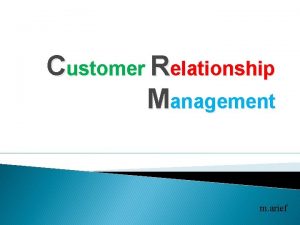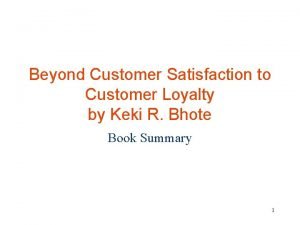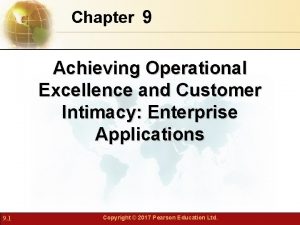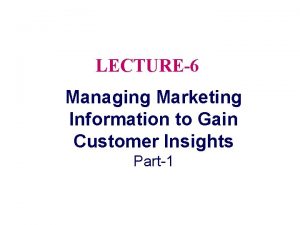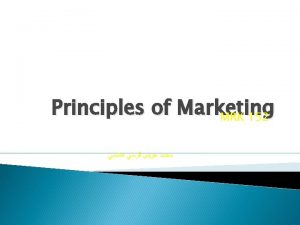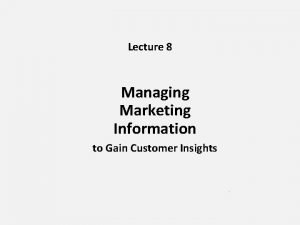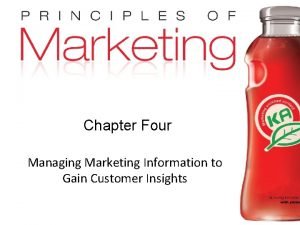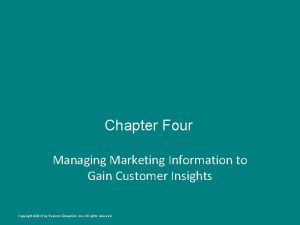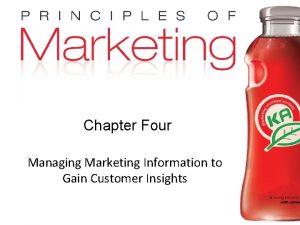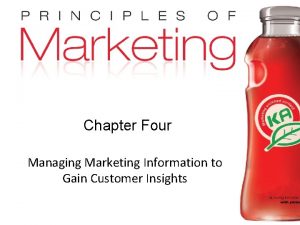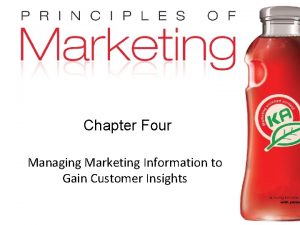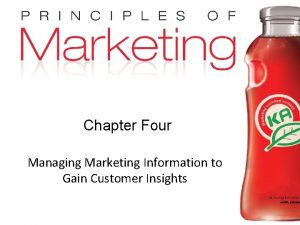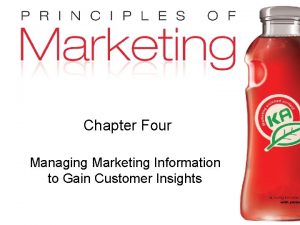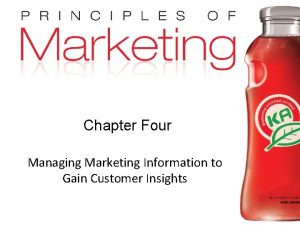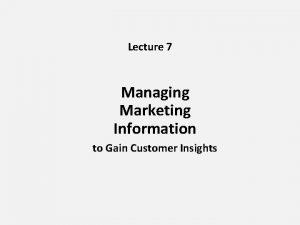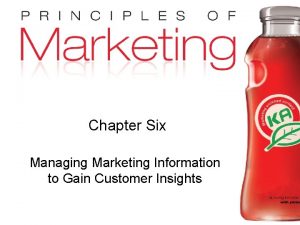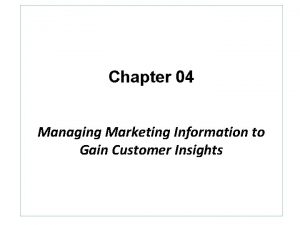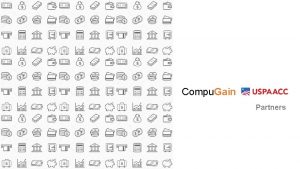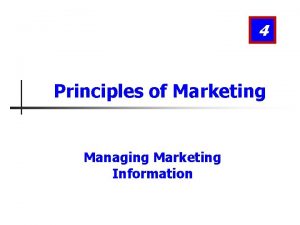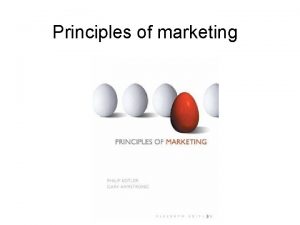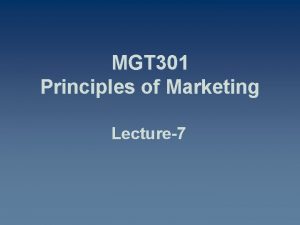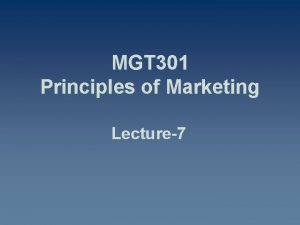LECTURE7 Managing Marketing Information to Gain Customer Insights































- Slides: 31

LECTURE-7 Managing Marketing Information to Gain Customer Insights Part-2

Developing Marketing Information Marketing Research Instruments Checkout scanners People meters Neuromarketing Technological devices

Qualitative Measures § Word association § Asks subjects what words come to mind when they hear the brand’s name. § Projective techniques § Give people an incomplete stimulus & ask them to complete it. § Visualization § Requires people to create a collage from magazine photo or drawings to depict their perceptions. § Brand personification § Ask subjects what kind of person they think of when the brand in mentioned. § Laddering § A series of increasingly more specific “why” questions.

Technological Devices § Galvanometers § Measure the interest or emotions aroused by exposure to specific ad or picture. § Tachistoscope § Flashes an ad to a subject with an exposure interval that range from less than one hundredth of a second to several seconds. § Eye cameras § Study respondents eye movements to see where their eyes land first, how long they linger on a given item.

Technological Devices… § Audiometers § Attached to TV sets in participating homes record when the set on & to which channel is tuned. § GPS § Global Positioning System – How many billboards a person may walk by or drive by during a day.

Step 2: Develop the Research Plan… Sampling Plan § Sampling unit: § Who is to be surveyed? § Sample size: § How many people should be surveyed? § Sampling procedure: § How should the respondents be chosen?

Types of Samples § Probability Samples § Simple random § Every member of the population has an equal chance of selection. § Stratified random § The population is divided into mutually exclusive groups i. e. age group & random sample drawn from each group. § Cluster § The population is divided into mutually exclusive groups i. e. city blocks the researcher draws a sample of the group. § Nonprobability Samples § Convenience § The researcher selects the most accessible population members. § Judgment § The researcher selects population members who are good prospects for accurate information. § Quota § The researcher find & interviews a prescribed number of people in each of several categories.

Step 2: Develop the Research Plan… Contact Methods § § Mail questionnaire Telephone interview Personal interview Online interview

Developing Marketing Information Marketing Research Strengths and Weakness of Contact Methods Mail Telephone Personal Online Flexibility Poor Good Excellent Good Quantity of data collected Good Fair Excellent Good Control of interviewer effects Excellent Fair Poor Fair Control of sample Fair Excellent Good Excellent Speed of data collection Poor Excellent Good Excellent Response rate Poor Good Cost Good Fair Poor Excellent

Developing Marketing Information Marketing Research Contact Methods § Focus Groups § Six to 10 people § Trained moderator § Challenges § Expensive § Difficult to generalize from small group § Consumers not always open and honest

Developing Marketing Information Marketing Research Online Contact Methods Internet surveys Online panels Online experiments Online focus groups

Developing Marketing Information Marketing Research Online Contact Methods Advantages • Low cost • Speed • Higher response rates • Good for hard to reach groups

Developing Marketing Information Marketing Research Online Contact Methods Disadvantages • Small samples • Skewed samples • Technological problems • Inconsistencies

Step 3: Collect the Information § The data collection phase of marketing research is generally the most expensive and the most prone to error. § Data collection methods are rapidly improving thanks to computers and telecommunications.

Step 4: Analyze the Information § The next to last step in the process is to extract findings by tabulating the data and developing frequency distributions.

Step 5: Present the findings § As the last step, the researcher present findings relevant to major marketing decisions facing management.

Developing Marketing Information Marketing Research Implementing the Research Plan Collecting the information Processing the information Analyzing the information Interpret findings Draw conclusions Report to management

What is Customer Relationship Management? CRM is the process of carefully managing detailed information about individual customers and all customer touch points to maximize customer loyalty.

Analyzing and Using Marketing Information Customer Relationship Management Touch points Customer purchases Sales force contacts Satisfaction surveys Service and support calls Credit and payment interactions website visits Research studies

Framework for CRM § Identify your prospects and customers. § Differentiate customers by needs and value to your company. § Interact with individual customers to improve your knowledge about their individual needs & to build strong relationship. § Customize products, services and messages to each customer.

CRM Strategies § Reduce the rate of customer defection. § Increase the longevity of the customer relationship § Enhance the growth potential of each customer through “share of wallet” cross selling, & up-selling. § Making low profit customers move profitable or terminating them. § Focusing more effort on high-profit customers.

Customer Retention- A tale from real life § Acquisition of customers can cost 5 times more than retaining current customers. § The average company loses 10% of its customers each year. § A 5% reduction to the customer defection rate can increase profits by 25% to 85%. § The customer profit rate increases over the life of a retained customer.

Database Key Concepts § Customer database § Database marketing § Mailing list § Business database § Data warehouse § Data mining

Using the Database § § § To identify prospects To target offers To deepen loyalty To reactivate customers To avoid mistakes

Don’t Build a Database When § The product is a once-in-a-lifetime purchase § Customers do not show loyalty § The unit sale is very small § The cost of gathering information is too high

Perils of CRM § Implementing CRM before creating a customer strategy § Rolling out CRM before changing the organization to match § Assuming more CRM technology is better § Stalking, not wooing, customers

Distributing and Using Marketing Information distribution involves entering information into databases and making it available in a timeuseable manner § Intranet provides information to employees and other stakeholders § Extranet provides information to key customers and suppliers

Other Marketing Information Considerations Marketing Research in Small Businesses and Nonprofit Organizations International Market Research

Other Marketing Information Considerations Public Policy and Ethics • Customer privacy • Misuse of research findings

Bibliography § Principles of Marketing by Philip Kotler & Gary Armstrong Fifteenth Edition, Published by Prentice Hall § Marketing Management – A South Asian Perspective by Philip Kotler, Kevin Lane Keller, Abraham Koshy & Mithileshwar Jha, 13 th Edition, Published by Pearson Education, Inc. § Principles and Practices of Marketing by Jobber, D. 4 th edition, Mc. Graw Hill International. § Principles of Advertising & IMC by Tom Duncan 2 nd Edition, Published by Mc. Graw-Hill Irwin.

The End "If you don’t have time to do it right, when will you have time to do it over? " John Wooden
 Marketing information and customer insights are
Marketing information and customer insights are Importance of rest
Importance of rest Consumers needs and wants are fulfilled through
Consumers needs and wants are fulfilled through Residential customer insights
Residential customer insights Customer insights
Customer insights Managing marketing information
Managing marketing information Demand measurement in marketing
Demand measurement in marketing Marketing information system kotler
Marketing information system kotler Danone
Danone All customers differ
All customers differ Managing customer relationships and building loyalty
Managing customer relationships and building loyalty Involves managing all aspects of a customer relationship
Involves managing all aspects of a customer relationship Customer relationship matrix
Customer relationship matrix Finer segmentation strategy
Finer segmentation strategy Marketing information systems and marketing research
Marketing information systems and marketing research Define marketing information management
Define marketing information management Marketing information systems and marketing research
Marketing information systems and marketing research Marketing information system kotler
Marketing information system kotler Marketing information systems and marketing research
Marketing information systems and marketing research Information gain feature selection
Information gain feature selection Information gain feature selection
Information gain feature selection Information gain
Information gain Information gain in data mining
Information gain in data mining Information gain
Information gain Yips model
Yips model Information gain
Information gain Information gain
Information gain Information gain
Information gain Customer relationship management and customer intimacy
Customer relationship management and customer intimacy Perbedaan customer relation dan customer service
Perbedaan customer relation dan customer service Beyond customer satisfaction
Beyond customer satisfaction Customer relationship management and customer intimacy
Customer relationship management and customer intimacy

